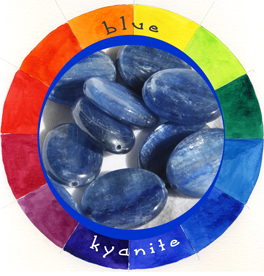b l u e
What can be said about blue? It's Crayola's #1 color in popularity and the top choice in
marketing (though not for food or cooking because it tends to suppress appetite). It's the
color of sea and sky and often used to promote feelings of tranquility and calmness.
Jewelry items with shades of blue include gemstones like sapphire, kyanite, lapis lazuli,
amazonite, aquamarine, blue topaz, and larimar.
•• d e s i g n s f e a t u r i n g b l u e
f u n f a c t s :

Blue light has shorter wavelengths (450nm-495nm) of the visible spectrum and the higher energy than green or red light.
The cones in our eyes are responsible for perceiving color, and though only about 2% of our
cones are sensitive to blue-violet light, we are capable of detecting similar intensities of blue
light compared with green or red.
Strangely, as popular as blue is today, a Radiolab episode explored the use - or relatively
lack of use - of the color "blue" in ancient languages such as Greek, Chinese and
Hebrew to question how we perceive and describe color
(see
Radiolab episode on Colors).
Sapphire, kyanite, Boulder opal, blue opal, lapis lazuli, sodalite, blue lace agate, larimar
and azurite are blue minerals found in jewelry. Azurite is often found with malachite in arid,
copper-rich environments, and beads often will be assembled with these components and stabilized
for a pleasing mottled appearance.
Swarovski crystal offers a variety of "sapphire" blues as well as "denium blue"
and "montana". Bright blue dyed pearls and wood tend not to look as nice as deeper cobalt or
blue purple colors, but sleet or midnight shades can be very nice.

 Blue light has shorter wavelengths (450nm-495nm) of the visible spectrum and the higher energy than green or red light.
The cones in our eyes are responsible for perceiving color, and though only about 2% of our
cones are sensitive to blue-violet light, we are capable of detecting similar intensities of blue
light compared with green or red.
Strangely, as popular as blue is today, a Radiolab episode explored the use - or relatively
lack of use - of the color "blue" in ancient languages such as Greek, Chinese and
Hebrew to question how we perceive and describe color
(see Radiolab episode on Colors).
Sapphire, kyanite, Boulder opal, blue opal, lapis lazuli, sodalite, blue lace agate, larimar
and azurite are blue minerals found in jewelry. Azurite is often found with malachite in arid,
copper-rich environments, and beads often will be assembled with these components and stabilized
for a pleasing mottled appearance.
Swarovski crystal offers a variety of "sapphire" blues as well as "denium blue"
and "montana". Bright blue dyed pearls and wood tend not to look as nice as deeper cobalt or
blue purple colors, but sleet or midnight shades can be very nice.
Blue light has shorter wavelengths (450nm-495nm) of the visible spectrum and the higher energy than green or red light.
The cones in our eyes are responsible for perceiving color, and though only about 2% of our
cones are sensitive to blue-violet light, we are capable of detecting similar intensities of blue
light compared with green or red.
Strangely, as popular as blue is today, a Radiolab episode explored the use - or relatively
lack of use - of the color "blue" in ancient languages such as Greek, Chinese and
Hebrew to question how we perceive and describe color
(see Radiolab episode on Colors).
Sapphire, kyanite, Boulder opal, blue opal, lapis lazuli, sodalite, blue lace agate, larimar
and azurite are blue minerals found in jewelry. Azurite is often found with malachite in arid,
copper-rich environments, and beads often will be assembled with these components and stabilized
for a pleasing mottled appearance.
Swarovski crystal offers a variety of "sapphire" blues as well as "denium blue"
and "montana". Bright blue dyed pearls and wood tend not to look as nice as deeper cobalt or
blue purple colors, but sleet or midnight shades can be very nice.